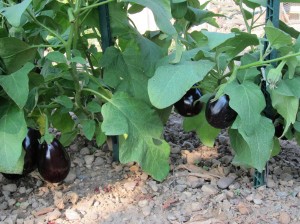L’aubergine, en ce moment au summum de sa maturité, est une plante potagère annuelle, cultivée pour son fruit, mais consommée comme légume. L’aubergine possède un potentiel antioxydant élevé. Elle est riche en fibres et permet donc un effet rassasiant par impression de volume, avec un apport énergétique limité et peut ainsi contribuer à la régulation du poids.
Outre la quantité intéressante de magnésium et de zinc qu’elle apporte, elle a l’avantage d’être diurétique grâce à sa forte teneur en potassium, tandis que la teneur en sodium est très faible. On reconnaît bien sa peau d’un violet profond, mais il en existe aussi des variétés jaunes, vertes et même blanches.
Avant de vous livrer ici ma recette toute simple de Tranches d’Aubergines Panées, mais aussi celle des Ballotins d’Aubergines à l’Agneau, je vous donne encore une petite note d’histoire qui est intéressante pour les curieux que nous sommes tous. Le terme «Aubergine», qui est apparu dans la langue en 1750, vient du catalan Albergina, qui l’a emprunté à l’arabe Al-bâdinjân. Enfin, le mot français est employé dans de nombreuses langues, y compris chez les Anglo-Saxons.
Alors,… à très bientôt sur laclassedecuisine.com !
 Eggplant or Aubergine, right now at the height of its maturity, is an annual garden plant, grown for its fruit, but eaten as a vegetable. Eggplant has a high antioxidant potential. It is rich in fibre and therefore allows a satiating effect by its volume, with an additional but limited energy intake and can contribute to weight regulation.
Eggplant or Aubergine, right now at the height of its maturity, is an annual garden plant, grown for its fruit, but eaten as a vegetable. Eggplant has a high antioxidant potential. It is rich in fibre and therefore allows a satiating effect by its volume, with an additional but limited energy intake and can contribute to weight regulation.
Besides the interesting amount of magnesium and zinc that it brings, it has a diuretic advantage due to its high potassium content, while the sodium content is very low. One recognises its skin that is deep purple, but there are also yellow, green and even white varieties.
Before I deliver you here my easy recipe of Breaded Baked Eggplants/Aubergines, but also the Aubergines/Eggplant Bunddles with Lamb, I want to give you a little knowledge point that is interesting to note for all the curious that we are. The term “Aubergine”, which appeared in the language in 1750, comes from the Catalan Albergina, that borrowed it from the Arabic Al-bâdinjân. Eventually, the French word is used in many languages, including among the Anglo-Saxons.
And now… Let’s meet soon at Laclassedecuisne.com !
